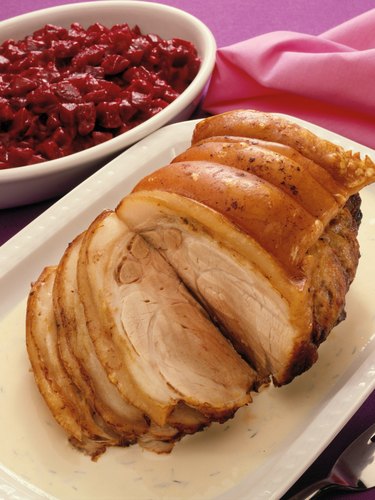
Pork is a traditional New Year's meal in many areas and is appropriate for any large gathering of friends and family. Some people are intimidated by cooking a large cut of meat or are unfamiliar with how to season or tenderize a roast. A well-cooked pork roast can liven any gathering and be the source of delicious leftovers during the week. It's actually very easy to make a juicy pork roast if you know the tricks.
Pork Roasts
Video of the Day
A pork roast is generally a larger cut that serves several diners. A roast can range between two and 20 pounds and be bone-in or boneless. Roasts with the bone left in are usually juicier. They are available in most cuts of meat and vary in tenderness depending on the cut. Some roasts are cured, smoked or pre-cooked, but most of the time it's best to purchase the meat fresh and cook your roast from scratch.
Video of the Day
Fat Versus Lean
Certain cuts of meat are fattier than other cuts. The amount of fat affects both tenderness and juiciness. Leaner cuts include the center cut loin roast, which is usually boneless, and a sirloin roast, which contains part of the backbone. The blade loin roast or rib end roast is also fairly lean, but it does contain more fat than the other two. Fattier cuts include the blade Boston roast or Boston butt roast -- a primal cut from the shoulder -- and the shoulder blade roast. Both of these cuts are bone-in. Although it's important to trim excessive fat from the roast you buy, leave a thin layer of fat to keep the roast moist as it cooks. Additionally, fat running through the roast, called marbling, helps to provide flavor and tenderness. Make sure you choose a roast that is well marbled throughout the entire cut. A boneless cut that is well marbled with fat is the boneless shoulder roll, which comes fresh, cured or smoked for a nice variation in flavor.
Visual Inspection
Handle the roast before you buy it so you can examine it for things the label won't reveal. Pork today is much leaner than in the past, so it should be easy to find a lean, well-marbled cut. The meat color should be pink with a slight gray to whitish tint and be fine-grained. Roasts cut from the loin are generally lighter in color than those cut from the shoulder or the leg. It should be firm and moist but not slimy, and it should smell clean and fresh with no bad odors. The color of the fat on the outer edges should be white and creamy. If it is yellowish, the roast is old and possibly spoiled. Packaging should be cool to the touch and have no splits or tears in the wrapping.
Cooking the Roast
Seasoning is important to give the roast a delectable taste and bring out the meat's natural flavor. Mix olive oil together with salt, pepper, paprika, garlic and onion powder and a mixture of herbs you like. After placing the roast on a raised rack in the pan, rub it down on all sides with the spice mixture. Make sure you place it in the pan with the fattier side facing upward. Preheat the oven to 450 degrees while you are applying the spice rub. Place a meat thermometer in the thickest part of the roast where it is not touching a bone. Put the pork roast in the center of the oven and cook it for about 10 minutes at that high temperature, which helps to seal in the juices. Then turn down the oven to 250 degrees. The roast should cook on a low temperature for anywhere between 50 to 80 minutes depending on its size. Roast the meat until the internal temperature reaches 150 degrees. Remove it from the oven and place a piece of aluminum foil over the top, allowing the roast to rest for 15 minutes. This is the most important secret of cooking a tender, juicy roast. Cutting the meat too soon after cooking, releases all the juices. Resting the meat allows the juices to settle into the meat.